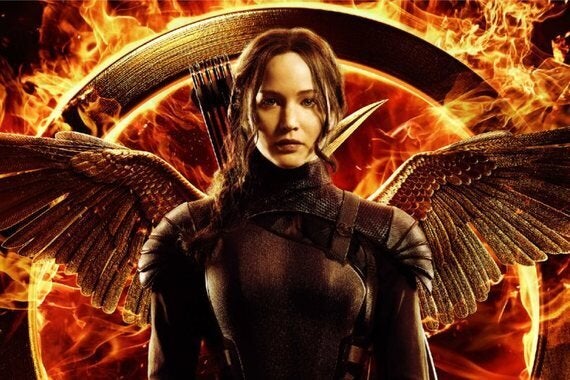
Picture: Lionsgate Films
It is a well-established marketing principle that, when targeting children, you need to appeal to boys. If you target boys, girls will happily get involved. The opposite, however, is not true. Because boys recoil in horror at the mere sight of girls' toys and books, don't they? We all know that's not true. But we pretend it is - and worse, we make it so.
It's not inconceivable that boys might show an interest in girls' toys. But this simply won't do, for everybody knows that even the most transient exposure to pink will leave boys permanently gender confused and forever compromise their sexuality. Interestingly, this does not seem to apply to girls. We trust girls' gender compass to confidently point to Venus, no matter what they wear, or read, or play with when they're young.
We worry about our girls being the victims of gender stereotyping, and rightly so. Just a few months ago, an Always campaign went viral for spotlighting how the expression 'like a girl' is meant as an insult, reminding us there are still too many social conventions that penalise girls for being girls. This, of course, is unacceptable.
But the truth is, gender policing is much stricter with boys than girls. Girls are allowed to enjoy boys' toys and books, wear trousers and dress up as clowns or pirates with kohl-painted moustaches. They can indulge in the other gender's pastimes without anybody batting an eyelid. Boys are not afforded such luxury.
This is a disservice to both boys and girls. It restricts the way boys experience the world, hampering their emotional development. And it sends young girls the message that their activities are unworthy of being pursued by boys. For girls it's okay, desirable even, to take on traditionally male traits. By behaving more like boys, they are bettering themselves. Conversely, it seems it would be degrading for boys to do girly things. So we don't let them.
Fast forward a few years and the boys have turned into teenagers. Now they don't just believe the lie - they embrace it keenly. Hence the gender segregation relegating women's culture to a lesser role: women's fiction, chick-lit, chick-flicks and so on. No self-respecting man would be seen indulging in such activities.
So we are back to the established marketing principle: to reach both boys and girls, we need to target boys. We need a male protagonist and, ideally, a male author. With the release of Harry Potter, J.K. Rowling was advised by her publisher to use her initials, to disguise the fact she was a woman.
Enter The Hunger Games.
In 2008, the Young Adult literature landscape was very different, and the book didn't exactly follow the beaten track: a dystopian in a market dominated by fantasy, contemporary and, since the advent of Twilight, paranormal romance. A premise whose cruelty was novel to western YA literature - and yet still had space for romance. And a 1st person narration from a female main character. All in all, quite an odd mix.
Despite the female protagonist, The Hunger Games was not targeted solely at girls. Scholastic saw the potential in capturing the 'cross-over' market - that YA niche appealing across genders and ages. And yes, to an extent this meant toning down the female references. Take the low-key and gender neutral cover, quite a departure from your usual YA jackets depicting the main character of the story.
But old stereotypes die hard. When the movie adaptation propelled The Hunger Games into a mass phenomenon, media and public alike stubbornly insisted on comparing it to Twilight. For many, the idea of a story centred around a young girl was so novel, they felt compelled to put the two titles in the same mould. It has a teen girl protagonist, so it's for teen girls only right? And that can't possibly be good, when we consider that Twilight's target audience was often mentioned as undeniable proof of the poor quality of the movie. "Steer clear," said movie critic Steve Newton, "unless you're a 14-year-old girl who gets all giddy at the thought of cute boys and first love." As if first love was a terrible female affliction and not a defining moment of growing up for both genders.
But here's the thing. The Hunger Games is a terrific trilogy. It's engrossing reading, with a compelling storyline and characters. When the movie adaptations came, they were good movies, with strong production values and committed performances.
And here's what happened: people responded to it. Boys included.
All of a sudden it was okay for a boy to read a book with a female protagonist. More than okay - it was cool. And Katniss is no male character in drag. Yes, there's action, bows and arrows and war. But there's also Katniss musing about having her legs forcibly shaved, jostling with her feelings for Peeta and Gale, navigating a complex mother-daughter relationship and being maternal towards her little sister. Make no mistake - Katniss is a girl.
The Hunger Games made it acceptable for boys to embrace a female perspective. In doing so it opened the floodgates to dystopians with female main characters and a broader readership base. Whilst it's difficult to know readers demographics by title, we can derive some insight by looking at the gender split of moviegoers: Divergent, the latest YA actioner with a teen girl protagonist, drew crowds which were 41% male, similar to The Hunger Games (39%) and quite a departure from Twilight (25%). Granted, dystopians are rooted in action/adventure. But it's a start. And as an aspiring YA author, I'm proud this is where the trend is gaining momentum. The new generation is showing us they can look past the gender roles we are trying to force upon them.